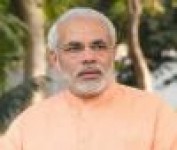TV debates polarise further
Picking one word or remark from the entire speech of a leader and dissecting it endlessly on prime time leads to further polarisation than was intended.
ALKA GURHA asks why the media endlessly debates non-issues.

'No Room For Real Issues', 'War of Words', 'Punch Fest' are a few headlines of editorials in prominent newspapers. When the print media condemns needless war of words, why debate such non-issues on television channels?
The recent 'Puppy' and 'Burqa' slugfests represent a sad trend of viewing debates purely from the TRP reading glass. I am talking about picking one word or remark from the entire speech of a leader and dissecting it endlessly on prime time. Whether it was the 'bee-hive' observation by Rahul, the 'puppy' remark by Modi or the 'maut ka saudagar' jibe by Sonia, sections of media single out the juiciest bone, chew it until our leaders fling another succulent one for consumption. While this may serve the purpose of political parties and their leaders, the common man gets baffled between the ruling tiger on land and the waiting crocodile in water. Mere potshots (news over noise or sense over sensationalism) do little justice to the credibility of news channels. After all, proof of the pudding is in the eating.
I am neither a Modi supporter, nor a Modi baiter. But, as a discerning television viewer, it is disheartening to note that most channels have cherry picked Narendra Modi's remarks to their advantage, resulting in further polarisation than was intended.
Times Now indulged in the usual high octane slanging match between Sanjay Jha and Smriti Irani on 'Fact versus Fact' debate on Newshour on July 15, 2013. Rather predictably, a refreshing debate on facts hit rock bottom ending up in a war of words.
The show choreographed by Rahul Kanwal on Headlines Today was less noisy and Yogendra Yadav, the only sane voice on the panel raised some pertinent questions. However the debate meandered towards obsession with the recent controversial words used by Narendra Modi in his speeches.
Not to be left behind, Sagarika Ghose on CNN-IBN conducted Face the Nation and discussed 'Can the trust deficit be reduced' after Rajdeep Sardesai had debated the same on 'India at nine' with Javed Akhtar, Abhishek Manu Singhvi and Nirmala Seetharaman.
Interestingly, towards the end of any such trivial debate, most anchors regain the moral ground and conclude that instead of expending energies on coining and dissecting terms of little relevance, the BJP and the Congress would do well to focus on issues that really matter to the average citizen.
Why then, should the media endlessly debate such non-issues?
While people are smart enough to see through the political games of polarisation, recent debates have created an impression that Modi was perhaps deliberately naming and denigrating one community. I am not sure, but after watching news channels it seems very likely that the attempt is to polarise voters. Rana Ayyub, a writer on Sagarika's show was convinced that the remarks by Modi were deliberate and that the damage was already done. Zafar Sareshwala, tried to focus the attention on Modi's positive actions in Gujarat but the other panelists, including the anchor, wanted to discuss Modi's words and not actions. A R Hussain, and Ali Naqvi, an advocate, present on the show felt equally hurt by the 'puppy' and 'burqa' remarks. Would the panelists have felt the same way if sections of media had not singled out and replayed controversial remarks by Modi?
The trend is to grab sound bites from politicians of all hues on isolated comments made by their rivals. These sound bites serve as fodder for debates on prime time. Not willing to be left behind, the warring factions come up with their wittiest best. So for every Rambo we have a Scambo and for every Scambo we have a Mogambo. For every Burqa we have Khakhi shorts and for every Bee-Hive we have an Elephant.
A relevant study by The Hoot reveals that channels air the same story ranging from 5 minutes to 44 minutes, or 1 minute plus to 37 minutes plus for a single story. However DD bulletins were most comprehensive in terms of number of stories covered. DD News had the maximum number of diverse topics covered in both its Hindi and English telecasts during the six days of monitoring.
Perhaps the wheel has come full circle and it is time for private news channels to telecast wholesome news and not debates centered on a single controversial remark by a politician. Though dissecting a single comment and grabbing eyeballs is relatively easy when compared to making in depth documentaries which talk about statistics or relevant data to showcase governance of any state, the media would do well to focus on issues that really matter.
Yes, it is the pre election year and our netas have every right to go berserk, but not the media. Yes, the polarising comments need to be condemned but not dissected beyond a point lest they cause further polarisation.
Subscribe To The Newsletter






